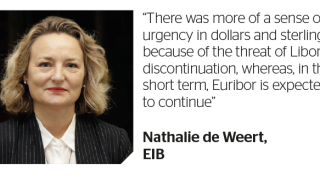EIB
-
Public sector dollar issuance has had a slower start to the year than usual — in part because of super strong conditions in other currencies — but SSA bankers are confident the strength of the deals that did come this week will boost the pipeline.
-
The European Investment Bank and Bank Nederlandse Gemeenten showed the strength of the dollar market on Tuesday as they sparked the sector into life for 2019 with benchmarks offering minimal concession. Another pair of SSAs are hoping to emulate that success on Wednesday.
-
The bond market is well ahead of schedule in its adoption of potential Libor replacements, with several issuers having printed notes linked to the Secured Overnight Financing Rate (Sofr) in the dollar market, and to the Sterling Overnight Index Average (Sonia) in sterling. Borrowers are setting strong standards for other participants to take up, as well as adjusting structures to ensure the eventual market is optimal. That does not mean the job is finished, of course. GlobalCapital spoke to some of the pioneers in the Sonia and Sofr markets about their work so far — and the challenges ahead.
-
The dollar market for public sector borrowers begins in earnest on Wednesday with a pair of borrowers out with benchmarks and bankers confident the deals will go well thanks to a demand/supply imbalance. The trades follow a small floater tap from a supranational on Monday that was the first syndicated deal of the year in the currency.
-
Issuers are flocking to the sterling bond market ahead of the crunch vote in the UK Parliament on prime minister Theresa May’s Brexit deal, which is scheduled for January 14. Issuers are taking full advantage of a parliamentary recess and a break in the political mayhem that saw the vote, originally due to take place last month, postponed due to May's fears it would be voted down. Burhan Khadbai and Tyler Davies report.
-
-
The European Investment Bank and KfW comfortably raised a combined £2.25bn on Thursday after receiving whopping investor demand for benchmark trades. This Friday is set to add to the sterling glut, with deals from the Asian Development Bank, Bank Nederlandse Gemeenten and Swedish Export Credit Corporation.
-
Secondary spreads in the euro public sector market have widened ahead of an expected flurry of benchmark issuance next week, with several issuers set to tap the market, according to SSA bankers.
-
KfW and the European Investment Bank mandated banks on Wednesday for the first sterling SSA deals of the year. Public sector borrowers are looking to pile into the sterling market before the crunch vote by the UK Parliament on Theresa May’s Brexit deal in mid-January, with deals expected in both Sonia-linked and fixed rate formats.
-
Public sector borrowers are confident going into the euro bond market next year, with reinvestments from maturing bonds held by the European Central Bank likely to cap any spread widening from the end of quantitative easing. But political threats — from populists polling well ahead of European Parliament elections in May, Brexit probably in March and the Italian government’s stand-off with the European Commission over its budget plans — are likely to bring volatility, meaning timing will perhaps be more important than in 2018. GlobalCapital brought together European SSAs, investors and investment bankers to discuss what 2019 holds for the euro market — as well as the SRI sector and new technology.
-
Work to bring the new risk-free rates to the dollar and sterling bond markets began in earnest this year as several issuers brought notes linked to them. But 2019 could be where clarity emerges on which of the different structures will win out.
-
The bond market is well ahead of schedule in its adoption of potential Libor replacements, with several issuers having printed notes linked to the Secured Overnight Financing Rate (Sofr) in the dollar market, and to the Sterling Overnight Index Average (Sonia) in sterling. Borrowers are setting strong standards for other participants to take up, as well as adjusting structures to ensure the eventual market is optimal. That does not mean the job is finished, of course. GlobalCapital spoke to some of the pioneers in the Sonia and Sofr markets about their work so far — and the challenges ahead.











